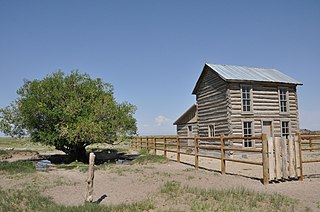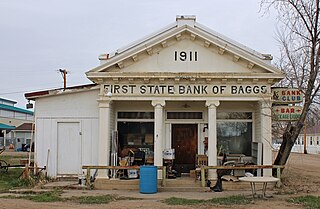
The Thomas Select School is a historic log building in rural Butler County, Ohio, United States. Constructed in 1810, the building has seen numerous uses, ranging from church to school to house. It has been named a historic site.

The John Ross House is a historic house at Lake Avenue and Spring Street in Rossville, Georgia. It was the home of the long-serving Cherokee Nation leader John Ross from 1830 to 1838, after his lands and fine home near the Coosa River had been taken by the state. Ross (1790-1866) led the Cherokee for many years, notably opposing the Cherokee Removal, which he was unable to stop. His house was declared a National Historic Landmark in 1973.

The Octagon House is a historic octagon house in Reading, Massachusetts. Built in 1860 by Doctor Horace Wakefield, it is a distinctive variant of the type, executed as a series of small octagonal shapes around a central cupola. The building is fashioned from large, heavy timbers in the manner of a log cabin, with long first-floor windows. The porches and eaves have heavy zigzag trim and brackets, some of which have carvings resembling gargoyles.

The Lake Fish Hatchery Historic District comprises nine buildings built between 1930 and 1932 by the U.S. Fish and Wildlife Service in the National Park Service Rustic style. The buildings exhibit a consistency of style and construction, with exposed gable trusses and oversized paired logs at the corners, all with brown paint. The district is located on the shore of Yellowstone lake near the Lake Hotel The hatchery was established to provide Yellowstone cutthroat trout eggs for state and federal hatcheries outside Yellowstone.

The Belly River Ranger Station Historic District in Glacier National Park includes several historic structures, including the original ranger station, now used as a barn. The rustic log structures were built beginning in 1912. Other buildings include a woodshed, built in 1927 to standard National Park Service plans and a cabin used as a fire cache.

The Lower Logging Lake Snowshoe Cabin and Boathouse were built in 1933 in Glacier National Park near the southwestern end of Logging Lake. The National Park Service Rustic boathouse stores rangers' canoes for patrolling the lake and their journeys between Upper and Lower Logging Lake patrol cabins. The Lower Logging Lake snowshoe cabin is nearby. They are a significant resources both architecturally and historically, constructed for backcountry patrols.

The Upper Logging Lake Snowshoe Cabin was built in 1925 in Glacier National Park. The National Park Service Rustic as a shelter for rangers patrolling the backcountry. The design is similar to that used in Yellowstone National Park, which was in turn adapted from U.S. Forest Service shelters, which were themselves adaptations of trapper cabins.
Billie P. Hall is a Chesapeake Bay log canoe, built in 1903, by Charles Tarr. She is one of the last 22 surviving traditional Chesapeake Bay racing log canoes to carry on a tradition of racing on the Eastern Shore of Maryland that has existed since the 1840s. She is located at Oxford, Talbot County, Maryland.
The HF Bar Ranch is located in Johnson County, Wyoming about 20 miles (32 km) northwest of Buffalo, Wyoming in the foothills of the Bighorn Mountains near Saddlestring, Wyoming. The ranch is a working cattle ranch comprising about 36 buildings, built between 1898 and 1921. The ranch is associated with Wyoming state senator and U.S. Congressman Frank O. Horton, who purchased it in 1911 with financial help from his investment banker brother-in-law and sister-in-law, Warren and Demia Gorrell. The Gorrells and their children spent summers in Wyoming, while the Hortons stayed year-round.

The Trujillo Homesteads are a historic ranch site near Mosca, Alamosa County, Colorado, not far from the Great Sand Dunes National Park. The area was first settled in the 1860s by Teofilo Trujillo, a Mexican sheep farmer. His son Pedro built a log cabin house beginning in 1879, along with other ranch outbuildings and structures. In 1902 the elder Trujillo's home was destroyed by fire during conflicts between English-speaking cattle ranchers and the Spanish Trujillos, who were by then major landowners in the area. The Trujillos sold their holdings, which became part the Medeno Zapata Ranch, now owned by The Nature Conservancy. The homestead area, including the surviving homestead and the ruins of the destroyed one, was declared a National Historic Landmark District in February 2012.

Hannah White Log House is a historic home located in West Whiteland Township, Chester County, Pennsylvania.The original land owner was John Willday (1768-1795). The house was built in 1795, and is a two-story, three bay, red oak log structure with a full basement. The logs are covered with stucco.

The Withers Log House, at 344 Wassou in Crystal Bay, Nevada, is a historic house that was built in 1931. It was listed on the National Register of Historic Places in 2000.

Dr. Joseph Bennett Riddle House is a historic home located at Morganton, Burke County, North Carolina. It was built about 1892, and is a 2-l/2-story, five bay, Queen Anne style frame house. It features a number of balconies, bay windows, and dormers. A three-story tower was added in about 1910.

The James Buchanan House is a historic log house in Nashville, Tennessee. It was built circa 1800 by James Buchanan, an early Nashville pioneer and signer of the 1789 Cumberland Compact. It's one of the earliest log homes still in existence in the area and is open to the public. The logs were hewn from Tennessee red cedars and nearly-extinct American chestnut trees. The floors were formed from Tennessee poplars and rest on a Tennessee limestone foundation. It has been listed on the National Register of Historic Places since March 29, 1984.

Old Settlers' Association Park and Rhodham Bonnifield House, also known as Old Settlers' Park and Bonnifield Cabin, is a nationally recognized historic district located in Fairfield, Iowa, United States. It was listed on the National Register of Historic Places in 1986. The park was established in 1907 as a preserve for the grasses, flowers and animals native to this area. It was also meant to memorialize the pioneers to Jefferson County and the sentiments of "freedom and equality, hospitality, sympathy and love of fair play" that motivated them. The focal point of the park is the Rhodham Bonnifield House, a log cabin built in 1838 in Round Prairie Township. It was used as a residence until 1902, and moved here when the park was established. This is the first park of its kind established in eastern Iowa. The house's historic designation is attributed to its 1907 reconstruction, and not its original construction. There are few pioneer log structures in Iowa that remain in their original setting. Those that remain have been reconstructed at another site to preserve them.
The Divide Sheep Camp, also known as Niland's Cabins, is a ranch site on the Little Snake River in Carbon County, Wyoming, near Baggs. The camp was established in 1909 for summer use by sheepmen of the Niland-Tierney Sheep Company and others in the Little Snake valley. Eventually becoming the Divide Sheep Company the company operated until 1974, leaving the structures intact. The principal elements are a one-story log cabin with a finished attic, measuring about 25 feet (7.6 m) by 40 feet (12 m) built in the early 1920s, a log bunkhouse dating to about 1914, a spring house and a generator shed. The site represents a moderately-well-preserved turn-of-the-century sheep camp.

The First State Bank of Baggs, also known as the Bank Club, is a building in Baggs, Wyoming, USA. Built in 1907–08 to house a bank, it is one of the relatively few original buildings left in Baggs. After the bank closed in 1924, the building became a doctor's office and, during Prohibition, it housed a bootleg liquor business. After Prohibition was repealed it became Baggs Liquor. In 1946, it was renamed the Bank Club Bar.
The Brents-Lisle House, near Greensburg, Kentucky, was listed on the National Register of Historic Places in 1984.
The Edwards House, on Kentucky Route 745 in Green County, Kentucky, United States, near Exie, Kentucky, was built in the 1840s. It was listed on the National Register of Historic Places in 1984.

Linwood Borough School No. 1, also known as the Leedsville Schoolhouse, is a former one-room schoolhouse built in 1873 and located at 16 West Poplar Avenue in the city of Linwood in Atlantic County, New Jersey. It was added to the National Register of Historic Places on December 20, 1984 for its significance in architecture and education. The Linwood Historical Society now uses the building as a museum.

















